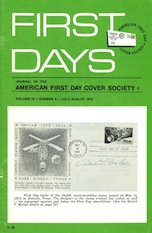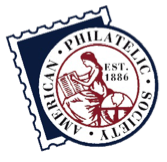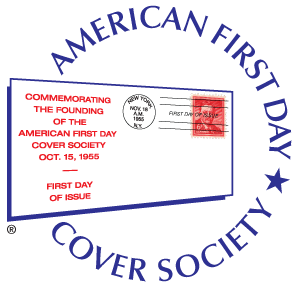The First Days Digital Archive
By Todd Ronnei
Note: The following article appeared in the July 2012 issue of First Days. The current version of the First Days archive now extends through 2022 (and no increase in price!)
The American First Day Cover Society is pleased to announce the availability of the entire run of the Society journal, First Days, in electronic format.

Launching this exciting product is a dream come true for us. But up until recently it seemed too daunting a task to even attempt.
The main obstacle was volume. Fifty-seven years of this journal yielded an astounding 34,736 pages of material! Those of you who have home computer scanners know how long it takes just to produce a single scan. I can’t imagine the time it would take to scan almost 35,000 pages in such a fashion, even if we had an army of volunteers willing to pitch in for such tedious work.
Over the past few years I looked for an alternative. Commercial services exist for this type of project, but the informal quotes we obtained were for such sky-high sums that we couldn’t even think about going down that road.

I began practicing using the machine’s scan function with an issue of First Days I disassembled by removing the staples. After some trial and error I settled on the optimal settings. Scanning an entire issue was a surprisingly speedy process, taking less than a minute. After scanning I then re-assembled the issue with new staples so the paper journal was back to its original state, no worse for wear after the scanning was complete. (Inserting new staples in the same place as the originals could sometimes be a challenge; it was often the most time-consuming part of the process!)
After scanning an issue, my next challenge was to re-order the computer file so the pages were presented in the correct order. For example, the raw scan of an 84-page issue produced a file with 42 pages, each scanned page containing two printed pages of the journal. However, those pages were not in 1-2, 3-4, 5-6, etc. page order, but rather 84-1, 2-83, 82-3, and so on. Each scanned page needed to be divided in half, and the resulting 84 pages then put in correct numerical order. How was I going to do that?
Adobe Acrobat Pro allows a user to modify PDF documents, and fortunately it was a program I already had. I assumed it was simply a matter of figuring out what commands to execute and the program would make short work of the task of splitting each page and putting the pages in the correct order.

Being stubborn, I started to research a solution to this problem (Google was my friend) and I learned it is possible for a user to add functionality to the program by installing an appropriate Javascript, essentially giving the program new capabilities it didn’t previously have. Even better, I found a pre-written script that added the page splitting function I needed. More searching yielded the basics of a page re-ordering script that after several days of frustration and tinkering I finally got to work.
With my Acrobat Pro program now modified for the functions I needed, post-scan processing of the PDF file was now a piece of cake that took only a few seconds to complete.
I began the scanning of each issue I owned in July 2011. I didn’t have personal copies of any issue published before 2000, but Foster Miller loaned me his near-complete collection of First Days. For those issues that Foster lacked, I turned to charter member Alan Warren, who filled in the gaps. I’m extremely grateful to both of them for allowing me to borrow their copies of the magazine, and for not flinching even after they were told I would be taking the magazines apart! (Not to worry, all issues were returned to their owners intact.) Scanning was completed in six months, about half the time I anticipated it would take.
Enough of the technicalities. The real story is the content you’ll find in the collection.
First Days is an incredible journal. From a humble 4-page quarterly newsletter beginning in 1955, it quickly became an authoritative semi-monthly magazine under editor Gerald Strauss. Sol Koved took the helm in 1960, a position he held without interruption for 30 years. Under Koved the magazine grew in frequency (eight issues per year starting in 1982) and in size (some issues in the 1980s topped out at 180 pages). Sol’s editorials, always thoughtful and direct, became the magazine’s most-read feature. When Koved retired in 1990, Barry Newton maintained the journal’s standard of excellence for a dozen years. Since 2002, Richard Sine and Peter Martin (now in his second stint as editor) have kept First Days among the best of philatelic journals.

Take myself, for example. I focus on certain stamp issues of the 1960s and 1970s. I want to know as much as possible about the cachets produced during that period, and it’s simply not practical to access the AFDCS Archives at the American Philatelic Research Library every time I want to learn more about a certain cachet or cachetmaker. Now with every past issue of First Days at my fingertips, the information I desire is convenient and quickly accessed. The write-ups I do for my collection and exhibits have already improved dramatically.
Another wonderful aspect of having all the back issues is learning the history of the Society and the people behind it. I joined the AFDCS in 1991, so the first 36 years of the organization were mostly a blank for me. Not any longer. In the course of scanning all those issues I constantly found myself stopping to read profiles of those whose names I knew but were otherwise a mystery to me. Case in point: I’ve certainly heard of Prof. Earl Planty, because the cachet catalog still bears his name, as do the annual cachetmaker awards. But now, thanks to a wonderful profile written by Dick Monty in the April 1, 1984 issue of First Days, I know Planty’s fascinating life story. (Did you know Planty founded and operated a successful business school—in Ethiopia?)

We’ve priced the entire collection at $79 on DVD, and are also offering a USB flash drive option for $89. Some may raise an eyebrow at the price—aren’t similar collections of journal archives offered by other societies cheaper? Yes, but it all comes down to the amount of content. When you examine how much you’re getting you’ll find the First Days archive is comparatively priced.
Let’s look at some examples. The Universal Ship Cancellation Society sells DVDs of their journal for the period 1932 to 2010 for $30 to members. That’s a lot of years, but the total page count is 14,251, or 21.1 cents per hundred pages. The First Days collection at $79 has 34,736 pages, which is a fairly comparable 22.7 cents per hundred pages. On the other end of the scale, the Meter Stamp Society’s journal archive costs $50 for approximately 4,700 pages—over $1 per hundred pages.
Need more convincing? You’ll get 395 issues of First Days for $79, which comes to just 20 cents per issue. Granted, issue number 1 is just four pages, but for the same 20 cents you’ll get those supersized issues from the 1980s, which were routinely in the 120- to 180-page range.
Included in the collection are a number of different indexes we’ve produced over the years, and a short guide with tips on searching multiple PDF documents at once.
Click here to view sample scanned issue.
Ready to order? It’s as simple as clicking the “Add To Cart” button below.

